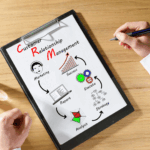
Share The Love:
Table of Contents
Did you know that email marketing is the most effective marketing channel to drive conversions and ROI? In fact, email marketing yields an average 3,800% return on investment, which means that you get $38 ROI for every $1 invested.
So the real question is, why aren’t you doing email marketing yet?
If the answer is “Because I don’t know how,” no worries! You’re in the right place. Here’s everything businesses need to know to get started with email marketing, from the foundations to current trends to tips for success every time you press send.
What is Email Marketing?
Email marketing is a segment of internet and digital marketing. If you send out an email to your customers (outside of an order receipt or direct responses to questions), chances are, it’s email marketing. It could be a newsletter to share information on the company’s behalf, a sales promotion, or even a blog update.
Either way, the goal is the same: to reach customers directly in their inbox.
How Your Email Marketing Strategy Fits with Digital Marketing
Because email marketing is part of your larger digital marketing effort, your email marketing strategy falls under the umbrella of digital marketing.
While social media strategies get a lot of attention these days, the truth is that email marketing campaigns can provide just as much personal connection to your customers–sometimes even more. Like social media, email marketing is intended to build relationships with your prospects.
And yes, you can certainly sell your products with email campaigns. However, when done correctly, email marketing campaigns also provide vital information about your prospects, leads, and customers that you couldn’t get anywhere else.
Anatomy of a Great Email
Pop quiz: what makes an email?
Hint: it’s more complicated than you think.
A marketing email isn’t a quick note to your friend, nor is it a question for your boss. It’s a piece of marketing copy, and it has to be written to achieve a specific goal. The difference is that unlike an ad, you have limited space to do it, and you have to write your copy with an eye toward how customers consume marketing through their inbox.
Broadly speaking, every marketing email can be classified in three main parts: the subject line, the preheader, and the body.
Subject Line
You want your prospect (or current customer) to follow through on your call to action. But first, they have to open the email. Which means your email marketing starts the moment they lay eyes on their inbox with a killer subject line.
This is a 60-character space to drive value. Basically, the recipient will open your email if they believe there’s some benefit to doing so or if they think they’ll miss out on something important. Good subject lines include things like “Your last chance to shop” or “Steal these time-savers”.
Preheader
A preheader appears under the subject line of an email–a.k.a. the preview text that a recipient can view before opening the email. It’s an important yet tragically underutilized element.
Typically, preheaders run between 35 to 80 characters. Think of it as an extension of the subject line. Once the subject line has the reader’s attention, the preheader further convinces them that the email is worth opening and reading.
There are a few strategies you can use for preheaders. The most popular is to continue to add interest on the main subject. Another option is to add intrigue–for example, “Pocket Sale” as the subject and “Heard you like carrying stuff” as the preheader. You can also turn to scarcity marketing, social proof, or even good old fashioned comedy.
Body
Unlike the body of a regular email, the body of a marketing email contains several component parts. These include:
- Images that populate
- Mobile rendering
- Call to action
- Links that work and track
- Ability to reply
- Unsubsribe link
- Physical mailing address
The unsubscribe link and the physical mailing address are both required for compliance with the CAN-SPAM Act, which governs the contents of commercial emails.
Everything else is a tool to engage or track your customer. Your links, for example, are invitations for your customer to click and dig deeper, while mobile rendering is a practical acknowledgement of how often people read their email on their smartphone.
Essential Email Marketing Trends for 2021
Now you know what makes a basic email. But what makes an email succeed? After all, an engagement rate of 22.86% is nothing to sneeze at (especially compared to a mere 0.6% for social media), but how do you reach that engagement for your emails?
Once you master the basics, driving engagement is all about mastering email marketing trends. Here are three big ones we see in 2021.
Authentic, Positive Content
Real talk: 2020 was hard. And lonely. Which meant that customers had more desire than ever for authentic content–and they haven’t stopped asking for authentic, positive content in 2021.
Think about the social media content we saw in 2020. It was all people trapped at home, shooting videos as best they could, figuring out how to make it work. It was a certain brand of authenticity, something that connected people no matter how far apart we were. Plus, engaging with online content offered a temporary reprieve from day-to-day life in the same four walls.
Now that we’re in 2021, the demand for authenticity hasn’t changed.
Personalization At-Scale
One of the biggest advantages of email is the ability to personalize at scale.
No one wants to feel like just another number. In fact, customers now demand personalization. They want businesses to treat them as individuals, and they reward businesses that do. Granted, they don’t want personalization at any cost–there’s a fine line between knowing your customer and knowing too much.
The good news is that it’s easy to send mass emails with personalization nowadays. With email design services and automated email services, including drag-and-drop features that make it crazy easy to craft an email, all you have to do is assemble the components, choose your email lists, and let the service take care of the rest.
Newsletter-Based Businesses
During the pandemic, businesses had to operate entirely online. And while some have gone back to the office, others have adapted to the virtual workspace (and taken advantage of how much their customers love it).
As a result, we’re seeing a rise in newsletter-based businesses.
This trend is especially popular among newspapers, but it’s also a great tool for e-commerce. And even if you have a brick and mortar storefront, a regular email newsletter is a great way to engage with customers on a regular basis.
How to Create an Email Marketing Plan
Much like a business plan, an email marketing plan is the foundation of your entire strategy. Think of it as the roadmap for the entire campaign. And even if you hire an outside marketing agency, it pays to have an email marketing strategy.
This is not to be confused with tactics. An email marketing strategy isn’t a collection of tactics cobbled together, either. Strategy is more thought-out than that.
Tactics are short-term, whereas strategy is long-term. Tactics are the methods and techniques you use to achieve a goal, while strategy is the overall collection of goals over time working towards a larger goal in a marketing campaign. Your strategy covers what you’re aiming for, why you’re aiming for it, and metrics for success. Otherwise, anything will look like success.
There are three steps at work: identifying context, identifying objectives, and preparation.
Identify Context
Before you craft your strategy, it’s a good idea to identify the internal and external context for your business’s campaign. Think of it like preparing for a hike by studying the landscape–you would prepare for lots of hills differently than you would prepare for a trek through a swamp.
In business terms, a good way to do this is by identifying your strengths and weaknesses, as well as current trends and opportunities that could benefit (or threaten) your campaign. You can also think about factors like political, social, environmental, economic, legal, and technological contexts.
Either way, your goal is the same: understand the world that surrounds your campaign.
Identify Your Objectives
Once you do that, you’re ready to set your objectives. Once you define your goals, it’s that much easier to set up an action plan and meet those goals.
To be clear, objectives and goals aren’t the same thing. Goals are your ultimate desired outcome, while objectives are milestones to contribute to your goals. The most effective approach is SMART goal setting (Specific, Measurable, Actionable, Realistic, Timely).
You should also think about how your campaign will help you achieve your goals, which includes think about what you want your customers to do when they get the email. Do you want them to click a link? Subscribe? Make a purchase? Be detailed about how you want the customer to engage.
Get Ready
Once you have context, objectives, and goals, it’s time to prepare your campaign. This includes tracking your campaign once it kicks off so that you can understand your progress.
For example, you should rigorously study your target audience, perform A/B testing and audience segmentation, and then carefully track performance. As the campaign progresses and you collect data, don’t just settle for observations–do something with them. Adjust your techniques as needed.
And don’t forget to adjust your campaign as needed to reflect the wider context. None of us were expecting a global pandemic in 2020, but businesses still had to adjust their strategies. The same goes for any other major context (even if it’s not on a global pandemic scale).
Email Marketing Tips to Drive Success
You’ve got your email content, you’ve got your strategy, and you know the latest trends. Now, it’s time to ensure your email marketing works.
Keep It Short
In the words of the Bard, brevity is the soul of wit.
No one wants to read long emails. They call to mind all those boring CEO newsletters that no one reads, or those pen pal-style emails from your aunt. Your customers don’t have the attention span for a long email–they want you to get to the point so that they know why this is worth their time.
Plus, shorter emails have better odds of landing in the primary inbox. Just saying.
Get Personal
Remember earlier when we said that your customers want personalization? That goes further than audience segmentation.
First of all, if you blast the same mass email at your email list every time, your email list will lose interest. They know you don’t care about individuals, you just want sales.
Customers like the little details. Like seeing their own name in an email, for a start–it feels a bit like getting an email from a friend. But you can go further than that.
One of the best approaches is to segment your emails based on the buyer’s journey (i.e. the buyer’s path to purchasing). A customer in the awareness stage, who has only just become aware that they have a problem, is quite different than a buyer who’s at the decision stage and ready to make a purchase.
Your Partner in Successful Email Marketing
For savvy marketers, email marketing is an art and a science. For savvy business owners, email marketing is an investment–in the right people, that is. After all, you have a business to run.
At Swell Enterprise, we know the tools that drive successful marketing as well as you know your business. So when you partner with us, you get the tools you need to succeed–no matter what your project may be.
Ready to invest in your business’s future? Then click here to check out our pricing options and find the perfect fit for you.
Tags
Share This



